Multi-disciplinary super-speciality hospital to conduct organ transplants, cosmetic surgeries, heart surgeries
Nima Wangdi
Providing some insights into upgrading the Thimphu national referral hospital to a multi-disciplinary super-speciality hospital (MDSSH), Lyonchhen Dr Lotay Tshering said the only cases referred from other hospitals should reach the MDSSH.
Lyonchhen was sharing the details with health professionals of Wangdicholing hospital in Bumthang last week. Once the hospital is upgraded to a MDSSH, there should be services for organ transplants, neuro surgeries, heart surgery, high-end reconstructive surgeries, cosmetic surgeries, formal infertility services, and kidney and liver transplants.
The project worth Nu 5 billion, as of last year is the biggest project in the health sector. It is also one of the pledges of the government.
“We should be able to treat all patients who currently have to be referred abroad at the national referral hospital. We spend about Nu.1B on referrals every year,” Lyonchhen said, adding that the government is also planning to construct a 60-70 bedded hospital in Taba, Thimphu.
Lyonchhen said that JDWNRH continues to see the same kinds of diseases and provides treatments that hospitals do without referring to Thimphu. “With the specialists in place, regional referral hospitals should make sure that the patients that could be treated at regional referral hospitals are not referred to JDWNRH.”
Health officials had been saying that most cases are self-referral, meaning people feel services are better than JDWNRH, overwhelming the hospital. Patients usually come to JDWNRH expecting better services even if the disease could be treated at the Basic Health Unit, dzongkhag and referral hospitals.
Meanwhile, Gidagom hospital will also be upgraded to a formal 100-bedded infectious diseases hospital. Of these, 50 will be dedicated for infectious diseases and the other 50 will be for general cases.
In making JDWNRH a national referral hospital, Lyonchhen said the institution of cluster hospitals started in 2020. For the cluster hospitals, Trashiyangtse is clubbed with Trashigang, Punakha and Gasa are clubbed with Bajo in Wangude, Lhuntse is with Mongar with specialists added to the hospitals wherever required and whenever possible.
“We are installing CT scan and dialysis in Samtse and Dewathang hospitals in addition to Mongar and Gelephu hospitals,” Lyonchhen said, adding that five CT scan machines should be enough for 700,000 people.
He said that for a population of less than one million, one MRI centre should be enough, but given the long distance, the government is mulling a new MRI centre.
Bhutan will soon start a MBBS college and send doctors out for subspeciality courses that we don’t have here. “In about 10 years, Bhutan’s health care will be one of the best in the world,” said Lyonchhen.
The hospital would provide high-level services in oncology – medical-oncology, psycho-oncology and hospice care, among others.
In the field of medicine, services like enteroscopy, high-resolution manometry, fibroscan services, and breath test facilities would be made available.


